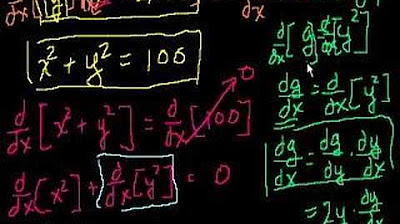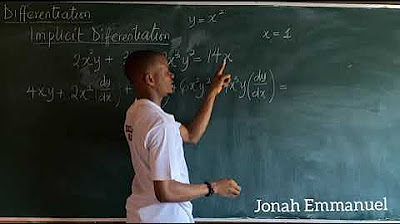Derivative of x^(x^x) | Taking derivatives | Differential Calculus | Khan Academy
TLDRThe video script discusses the process of solving complex implicit differentiation problems, using the natural logarithm to simplify expressions. It walks through a classic problem, y = x^x, and its derivative, then tackles a more complicated problem, y = x^(x^x), applying the product rule and chain rule. The solution involves taking the natural log of both sides and using previously derived results to find dy/dx, showcasing the elegance and complexity in mathematical operations.
Takeaways
- 📚 The problem involves finding the derivative of y = x^x with respect to x.
- 🔍 The approach to solving the problem is through implicit differentiation and the use of natural logarithms.
- 🌟 The natural log method simplifies the equation by converting y = x^x to ln(y) = x*ln(x).
- 📈 The derivative of the natural log form with respect to x is found using the chain rule and product rule.
- 🤔 The derivative of ln(y) with respect to y is 1/y, and the derivative of ln(x) with respect to x is 1/x.
- 🧠 The key to solving the problem is recognizing the relationship between the derivative of x^x and the natural log rules.
- 🚀 The derivative of y with respect to x is given as dy/dx = y*(ln(x) + 1)/x.
- 🌐 The script introduces a more complex problem, y = x^(x^x), which follows a similar solving process.
- 🛠️ The derivative of the complex problem is calculated using the previously found derivative of x^x.
- 📊 The final result for the complex problem is expressed as a combination of terms involving x, natural logs, and y.
- 🎓 The script highlights the elegance and complexity that can be found in mathematical operations and derivatives.
Q & A
What is the main problem discussed in the script?
-The main problem discussed is finding the derivative of y with respect to x for the function y = x^x.
How does the script suggest solving the main problem?
-The script suggests solving the problem by taking the natural log of both sides of the equation and then applying the power and chain rules to find the derivative.
What is the significance of taking the natural log of both sides of the equation?
-Taking the natural log simplifies the exponential function into a form that can be more easily differentiated using standard rules like the power rule and chain rule.
What is the derivative of y with respect to x for the function y = x^x?
-The derivative of y with respect to x for the function y = x^x is dy/dx = x^x * (ln(x) + 1).
What is the more complex problem introduced after solving the main problem?
-The more complex problem introduced is finding the derivative of y with respect to x for the function y = x^(x^x).
How does the script approach the more complex problem?
-The script approaches the more complex problem by again taking the natural log of both sides and applying the rules of differentiation, using the previously found derivative of x^x.
What is the final expression for the derivative of y with respect to x for the function y = x^(x^x)?
-The final expression for the derivative is dy/dx = y * (x^x * ln(x) + 1/x * x^(x-1)) where y = x^(x^x).
What is the importance of the chain rule in this context?
-The chain rule is important for differentiating composite functions, which is the case when dealing with functions like y = x^x or y = x^(x^x) where the outer function is also an exponential function.
Why is it beneficial to solve the simpler problem first?
-Solving the simpler problem first provides the foundational understanding and tools needed to tackle the more complex problem, such as the derivative of x^x, which is directly applicable to the complex problem.
How does the script illustrate the elegance of mathematics?
-The script illustrates the elegance of mathematics by showing how complex problems can be broken down into simpler, manageable parts, and how seemingly complicated derivatives can result from simple and elegant operations.
What is the role of the product rule in differentiating the given functions?
-The product rule is used to differentiate the functions when expressing the derivative of y with respect to x, as it helps in finding the derivative of the product of two functions, namely x^x and ln(x).
Outlines
📚 Solving Implicit Differentiation Problems
The paragraph introduces a classic implicit differentiation problem where the function y is expressed as y = x^x. The speaker explains that the challenge lies in the unconventional exponent, which doesn't fit the power rules directly. The solution involves taking the natural logarithm of both sides of the equation, which simplifies the expression to a form that allows the application of power and logarithm rules. The speaker then derives the derivative of y with respect to x, using the chain rule and product rule, and emphasizes the utility of this method for solving more complex problems later in the video.
🤔 Tackling a More Complex Implicit Differentiation
The speaker presents a more complex problem where y is defined as x^(x^x) and the task is to find the derivative dy/dx. The approach is similar to the previous problem, using natural logarithms to simplify the expression. However, the presence of nested exponents adds an extra layer of complexity. The speaker applies the chain rule and product rule, referencing a previously solved expression for the derivative of x^x. The final result is a complex expression that incorporates the natural logarithm of x, exponents, and a term involving 1/x. The speaker highlights the elegance of mathematics, where complex operations can sometimes yield surprisingly simple or intricate results.
Mindmap
Keywords
💡implicit differentiation
💡natural logarithm
💡chain rule
💡power rules
💡product rule
💡exponential functions
💡derivative
💡variable exponent
💡simplifying equations
💡rates of change
💡complex problems
Highlights
The problem presented involves implicit differentiation with the equation y = x^x.
The approach to solving this problem is to take the natural log of both sides of the equation.
After taking the natural log, the equation becomes simpler: ln(y) = x * ln(x).
The derivative of y with respect to x can be found by applying the chain rule and product rule.
The derivative of ln(y) with respect to y is 1/y, and the derivative of ln(x) with respect to x is 1/x.
The final expression for the derivative is dy/dx = y * (ln(x) + 1) / x.
An even more complex problem is introduced where y = x^(x^x).
The natural log is used again to simplify the complex exponent in the new problem.
The derivative of x^(x^x) with respect to x is found by applying the previously derived rule for x^x.
The final expression for the derivative of the complex problem is dy/dx = y * (x^x * ln(x) + 1/x * x^(x-1)).
The process demonstrates the power of logarithms and differentiation rules in solving complex problems.
The solution to the complex problem showcases the elegance and unexpected results that can come from mathematical operations.
The video emphasizes the importance of understanding and applying basic mathematical tools to tackle more difficult problems.
The problem-solving approach can be applied to a variety of mathematical challenges, not just those involving exponents.
The video serves as a tutorial on implicit differentiation and the application of natural logarithms.
The solution process is detailed, walking through each step to ensure clarity and understanding.
The video highlights the potential for elegant solutions even in the face of complex mathematical expressions.
The transcript provides a comprehensive guide to solving implicit differentiation problems involving exponents.
Transcripts
5.0 / 5 (0 votes)
Thanks for rating:





